08 Dec 2022
Outdoor Art: Winter 2022
-
Richard Campbell
Richard Campbell is a Musqueam carver who has been honing his craft for over 40 years. He comes from a family of carvers, including his grandfather, three uncles and many cousins, all of whom have influenced his approach to working in three dimensions. Campbell’s work has evolved from traditional forms to that of a modern, interpretative style. In addition to working in bas-relief, he has created sculptures of various scales and for different purposes. He was the main carver for the 20’ tall house post in front of the Musqueam Band Office in Vancouver and contributed to the building of the Coast Salish-style longhouse that is part of the collection of the Canadian Museum of History in Hull, Quebec. Alongside his artmaking practice, Campbell has worked as an archaeologist field assistant with the Musqueam Indian Band for some 23 years. Both occupations reflect his dedication to ensuring his culture lives on for future generations.
Read More
-
James Hart (7idansuu)
Born in 1952 into the Eagle Clan at Old Massett, Haida Gwaii, Haida master carver and hereditary chief 7idansuu James Hart has been carving since 1979. In addition to his monumental sculptures and totem poles, which can be seen at the Museum of Anthropology on campus, he is a skilled jeweler and printer and is considered a pioneer among Haida artists in the use of bronze casting. Hart is the recipient of the Order of British Columbia (2003), an Honorary Doctorate of Letters from the Emily Carr Institute of Art and Design (2004), the Queen’s Diamond Jubilee Medal (2013), and the Audain Prize for Visual Art (2021).
Read More
-
Holly Schmidt
Holly Schmidt (Canadian, b. 1976) is an artist, curator and educator engaging in embodied research, collaboration and informal pedagogy. She creates site-specific public projects that lead to experiments with materials in her studio. As the core of her work, Schmidt explores the multiplicity of human relations with the natural world. During her residency with the Belkin’s Outdoor Art Program, Schmidt has utilized spaces between campus buildings through a process of collective knowledge production. These artistic and ecological interventions foster relationships with plants in a manner that is both distinct from the formal, university landscape design as well as from standard notions of gallery space. Schmidt has been involved in exhibitions, projects and residencies at the Belkin Outdoor Art Program; the Burrard Arts Foundation, Vancouver; AKA Gallery, Saskatoon; Charles H. Scott Gallery, Vancouver; the Santa Fe Art Institute; Burnaby Art Gallery; and Other Sights for Artists’ Projects, Vancouver.
Read More
Introduction
In this edition of the Outdoor Art newsletter, we consider the ways in which artists’ practices are grappling with the politics of public space from both a local and global perspective. Through connections between two public art projects currently underway on the UBC campus with those being featured in the Belkin’s upcoming exhibition The Willful Plot, we can trace how the artworks forefront life cycles and the range of conditions that sustain or disrupt them. These artists explore in the broadest sense their relationship to the land.
To add to past updates, the Belkin’s Curatorial Assistant Carmen Levy-Milne presents her interview with Musqueam artist and archaeologist Richard Campbell about his experience working on the Bronze Disc, an artwork created for the base of James Hart’s Reconciliation Pole. In contrast to the pole’s verticality and the story it tells of life before, during and after Indian Residential Schools, the Bronze Disc brings our attention to the land and the foundational aspects of being situated in this place – the unceded territories of xʷməθkʷəy̓əm (Musqueam).
Curator of Outdoor Art Barbara Cole reflects on the work of Holly Schmidt, an artist committed to addressing the climate emergency through her socially-engaged practice. Fireweed Fields challenges the university’s colonial landscapes through the introduction of horticultural practices that encourage increased biodiversity. For Schmidt, the plants she cares for and learns from fulfills the roles of both material and subject in her work.
Expanding on how artists have worked with life cycles in relation to the garden, The Willful Plot exhibition imagines a story with beginnings, middles and endings that are influenced by ecology, sociality, belief and possibility. Curator Melanie O’Brian writes, “If the garden is a site and a practice analogous to the studio, it exists within and beyond the logics of human time, holding its own agency, yielding non-linear narratives that give and take, fruit and compost, persist and disappear.”
At this moment in the seasonal cycles, with the slowing of growth and storing of sustenance, the colder months present us with the time to reflect upon our relationships with land, flora, fauna and their interrelatedness.
A Conversation with Richard Campbell
by Carmen Levy-Milne with support from Barbara Cole and Jay Pahre
Content Warning: This article includes conversations about Canada’s Residential School System and the abuse perpetuated at these governmental institutions. We encourage readers to take care of themselves when reading these conversations. If you need support, please visit the Residential School History and Dialogue Centre on the UBC Vancouver campus or online.
On 1 April 2017, UBC witnessed the raising of Reconciliation Pole: Honouring a Time Before, During and After Canada’s Indian Residential Schools. Designed and carved by Haida artist, master carver and hereditary chief 7idansuu (Edenshaw) James Hart using traditional Haida sculptural techniques, Reconciliation Pole confronts viewers with the traumatic impact of residential schools, while memorializing the children who did not come home, and recounting the stories of a time before the residential school system. Through remembering these recent histories and their ongoing effects, Reconciliation Pole looks to emphasize the entanglement and responsibility of both non-Indigenous and Indigenous people to build a more respectful and reciprocal present and future.
As a final addition to Reconciliation Pole, Hart envisioned a bronze disc installed at the base of the 15-metre red cedar pole to acknowledge the physical contact point where the work meets Musqueam land. As a collaborative effort between Hart, Musqueam master carver Richard Campbell, and Kwakwaka’wakw artist Max Chickite, the carving of this large-scale project began in the studios of the UBC Audain Art Centre in December 2020 with support for the commission from the Audain Foundation. This interview with renowned knowledge keeper, carver and archaeologist Richard Campbell took place as he navigated the final steps before the Bronze Disc’s installation, set to take place during the Winter 2022/23 semester.
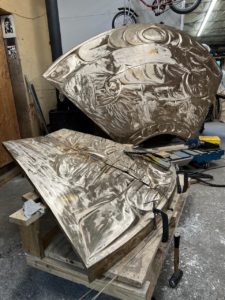
With UBC’s Vancouver campus situated on the traditional, ancestral and unceded territory of the xʷməθkʷəy̓əm (Musqueam) people, this new addition offers a unique opportunity to educate students, faculty and staff about the land on which we are privileged to learn, work and live. In this interview, Campbell reflects on his own healing process, the initial design stages of the disc, the challenges that he encountered along the way, as well as what he hopes visitors to the pole will learn from this new addition.
Richard Campbell: My name is Richard Campbell. I am a Musqueam elder and knowledge keeper, to my knowledge [laughs]. I have been doing archaeology for almost 25 years. I have been carving for just over 40 years.
I’m also a residential school survivor, which was very important for me when I was asked to be part of this project. Lots of times big artworks are looked at as dollar signs, but [this project] is way more than that to me. It’s a healing process. This residential school healing, some people don’t get over it, some people have very difficult times even speaking about it. You can’t imagine the abuse that I’ve been through, to hear there are people out there that have had it ten times worse than me, my heart really feels for them on their recovery. So this was a very uplifting project for me, in that healing part.
[Working on the Bronze Disc] expanded my work. I’ve always tended to do smaller things. I was happy staying away from these large projects. There’s a lot more headaches in them than gratification sometimes because of the process, the stress, and everything that has to take place with it. It’s not like picking up and making a plaque, and you’re done in two or three days. With these jobs, you’re done in three, six months, maybe a year. It’s a long process to have the patience for.
It’s been brought to my attention that carving and archaeology are two things that go hand in hand in keeping our culture alive. Finding our past and carving the present. It’s very gratifying to hear, both in doing archaeology and in my carving as well, they are two jobs that I really enjoy doing.
Carmen Levy-Milne: Have you always seen overlap in your practice as an archaeologist and as a carver?
RC: No, you know, it’s just in recent years that it’s been put to me in those terms. What I do in archaeology, it’s keeping our culture alive and proving facts, where we were, what we made, how we made these different stone and bone tools, and made rope out of sinew, and weaving.
To try to do these things now, in modern times, even with technology, is very difficult. But to have the knowledge, way back, of what our ancestors did, they had patience and probably a lot more time than we do. Because today’s pace is rush, rush, rush. Everything’s now or tomorrow is too late. It’s hard in our fast-paced lifestyle that we live in now, it can be really difficult and challenging to meet all the expectations in the short timeframe that you’re expected to do it in.
CLM: Is that one of the biggest challenges you saw when approaching this project?
RC: Yeah, because it’s like, you go to work, you carve. You go to work every day, all day. You don’t say I just don’t have that inspiration today and take that day off. You can’t do that. Whether you like it or not you have to go to work.
CLM: How did you come to be involved in this project?
RC: It was an honour to work with Jim [Hart]. Right now there’s a protocol for commissioning artwork – and with Jim we didn’t have to go through that because Jim came to me.
Jim was a good friend with my late buddy across the street. He was my best friend. He would come over and we would have coffee. He’d sit and watch me carve every day, all day. I don’t know why he never ever picked up the knife, maybe he was too scared of sharp knives. But it was through fishing that Jim and him were acquainted, so Jim came to see him and asked if he knew any good carvers, and right away he said, “Oh yeah, Richard Campbell.” So that’s how Jim and I got introduced, through my late friend.
Barbara Cole: So artist to artist.
CLM: How did you approach this project and how did the collaboration with James Hart take shape?
RC: I did an awful lot of pencil work. Drawing isn’t particularly one of my strong points. Give me a knife, it’s easy to carve and cut the wood, shape the wood, I’m very comfortable with that. But a pencil and a piece of paper, it’s a lot more challenging, especially when you have a certain design that somebody else wants on the project. So it took me a long time to finally come up with a design that Jim was happy with.
CLM: The salmon is central to the disc’s design; can you speak to its significance and how the design process unfolded?
RC: It’s a design that was suggested he wanted, but I did several, several, several designs. To do a sketch, a rough sketch, a good sketch, then get it to a final sketch in a scaled dimension of 15 feet in diameter, right off the get-go you’re working with numbers and figures to put on a sheet of paper. You get more than 8×11”; quarter that 8×11 and scale it up to 15’ diameter, yeah it’s a little bit of division and math to get it to that and then you do a final design on top of that.
It’s kind of cool that the disc was made in quarters. So, the design gets replicated four times, which comes to involving the four seasons. It being a salmon shows how important salmon was to not just Musqueam but a lot of Indigenous people. There are other fish on the west coast, which is what drives our villages – herring, halibut, cod, which are all very important staples. The salmon are seasonal. As a people, we canned or dried or smoked the salmon so we had it for the other three seasons.
BC: And you were a fisherman as well.
RC: Yep, I commercial fished. Salmon and herring.
CLM: Is this one of the biggest commissions you’ve worked on? Did that change the way you worked with the material?
RC: I was on the crew for the building of both the Coast Salish and West Coast [Nuu-Cha-Nulth] Houses that are now at the Canadian Museum of History in Hull, Quebec. I also did one of the house posts in front of the Musqueam administration building that’s a bit bigger than [the Bronze Disc].
Doing that house post was a lot more fun [laughs] because I invited all the schools around South Vancouver, and all the kids came down and made a field trip while I was carving. They would swing away with the adze, and after they were gone I would go and fix it up. Because it was a big log they weren’t going to ruin it. But definitely I had to fix it up after they left. It was a lot of fun through the summer. It was nice to see the kids coming in and picking up a very dangerous tool and enjoy swinging it and seeing their faces, the enjoyment and that little gleam in their eyes while they were cutting away, it was really nice.
CLM: How did the design process evolve at the Audain Art Centre?
RC: Having Jeremy [Jaud]’s crew blow up the design to fit in quarters saved a lot of time. I don’t know how long it would have taken me to put [the drawing] on the foam otherwise. I still would have had to trace it because we repeated the same design on all four quarters, with some changes around the centre of the pole because it wasn’t a perfect circle.
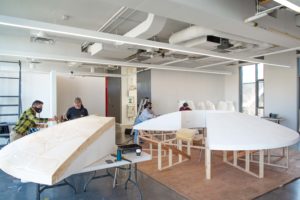
CLM: Was this one of your first times working so collaboratively on a project with so many different people and moving parts?
RC: Yes and no. In a different way, in a more technical and I guess a more sophisticated way, maybe yeah. The technical part involved was different than when I did the [Musqueam house post.] I have a buddy who is a computer whiz, he did all my scaling for me from the size of the log, the length and the diameter. I just brought him the measurements and the computer fixed it up.
You know, I actually just came across my paperwork for all of the numbers for the scaling of the house post just last month. I thought, oh, I should frame this and hang it up in the band office. There’s some cool information as to the building of the house post and I know there are people technically inclined who might see that and look at the post and appreciate it. It’s an idea that could be proposed to our Council, to say, let’s hang this up in the band office. Because doing that house post was a lot of fun, but so was [the Bronze Disc].
It wasn’t that much fun getting that salmon design though, I went through an awful lot of paper [laughs]. My late cousin, he was an awesome carver, he did all my pencil work for me, and all I had to do was carve.
BC: Max Chickite, to Jim’s specification, formed the overall disc, you know it’s slightly curving, and if I remember correctly, Jim said it was similar to that of a spindle whorl. When you were designing the salmon motif, were you thinking of what that would be like if it were indeed a spindle whorl?
RC: The general shape of it and form to me is a giant spindle whorl. And then having the pole in there is the stick with the spindle to spin it – it could very well be.
BC: I wondered if you were thinking about that spindle whorl spinning, and what happens to the image, it almost becomes animated in a way.
RC: That would be a neat thing to design, something in motion so that when it’s spinning it makes you see a design. That would be very cool.
Quite a few years ago I did some spindle whorls for the MOA. They wanted them to be hands-on for classes to come in. They built little boxes and put them in there, and kids could spin the disc. I did the designs. I’m pretty sure I did four of them. I’ve seen one on display and one in one of the boxes.
I could almost say it is like a spindle whorl design on the base of this pole. There are so many things, details that you don’t really see in the beginning of the process.
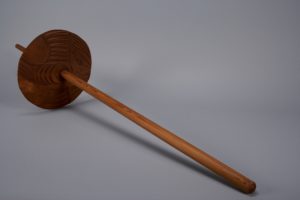
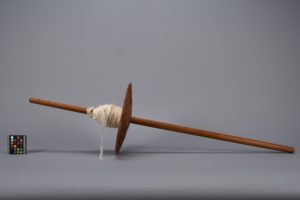
CLM: Reflecting on the creation, because we’re very close to the installation of the disc, is there anything that you wish for visitors to the pole now to understand, learn or experience from this new addition?
RC: I’d like to see people that are going to view [Reconciliation Pole and Bronze Disc] acquire more knowledge about the impact of colonization to give them a little bit more insight into why these were made. There’s limited information on that. [Visitors] can’t be expected to do all of the work of reconciliation – reconciliation is more a nationwide thing. But in that, there are small things, small parts, that we can do to contribute to that knowledge, any bit is helpful. It’s less than what the government needs to do.
CLM: I agree, the government has to respond and address the ongoing impacts of colonization on a larger scale, but still, as individuals, we have a responsibility to educate ourselves and act locally. It’s the least we can do.
BC: Reconciliation Pole has become such an important monument for bringing people together. People are visiting the pole to mourn, honour loved ones, leave offerings, not just on the National Day for Truth and Reconciliation, but throughout the year.
RC: It’s tough, especially given the issues that need addressing, that’s going to be the hard part. Where to begin on something like that, and whose task is it to fill it?
CLM: Thank you so much for allowing us into your home to speak with us today.
RC: Oh you’re very welcome.
*This is an edited and condensed transcript from an interview that took place at Richard Campbell’s home in Musqueam on 25 October 2022
Reflections: The Belkin’s Outdoor Art Residency
Fireweed Fields is a durational art project, a project that was born of Holly Schmidt’s (slow), Vegetal Encounters residency in the Belkin’s Outdoor Art program. Rather than beginning with a proposal for what it would become, Schmidt began her residency with what it could be, and with that embedded potentiality, developed a program of activity that would make her learning public.
Schmidt’s proposition that we have much to learn from plant and animal life is reflected in the green zones we cross to arrive at the Belkin Art Gallery’s entrance. Veering off from the long straight stretch of the maintained green lawns of UBC’s Main Mall, the impact of seasonal changes are more discernible here. From warm to cool, lush to dormant, this green threshold holds forth a place that is responsive and adaptive to change. This is a place reserved for generative action.
With winter settling in, Fireweed Fields is moving into a period of quiescent repose. There is a sense of latency, a quiet suspended moment of regeneration and renewal. In two of the three fields, the long dried grasses lay flat, their stalks dry, seeds spent. In the third, Schmidt has led efforts to effect a more radical transformation – an expanse of freshly raked soil appears bald and exposed, save for a thin layer of leaves and needles accumulating along its perimeter.
In this zone of what one might assume to be fallow land, seeds have been sown – a mix of fireweed, lupins, yarrow and Idaho fescue for the drier edges, and a wildflower blend that includes native annuals, perennials, grasses and rushes. Scattered before the frost, the seeds are undergoing the slow process of stratification, their husks gradually softening over the colder months until, with the irresistible warmth of spring, they will sprout and adapt to the conditions that are presented – through late frosts, heat domes or atmospheric rivers, the plants will flourish or fail, illustrating without any form of artifice how climate affects all of our futures.
The overlaying of actions and their effects is inherent to both Fireweed Fields and Schmidt’s ongoing companion project, Forecast.
We are calling for
occasional whips
of mountain air
to scatter
magnolia leaves
on flagstones.
Exposed skin
will bite against
the tumbling,
silver air.
-Dora Prieto [1]
The gallery’s clerestory windows angle above and over a section of Fireweed Fields, refracting natural light while offering fuzzy reflections of what lays below. Each of the 18 window panes frames 18 unique texts, their words made from letters cut from mirrored vinyl. The complexity of this doubling up of reflective surfaces implicates the viewer who, with each step, is caught in the action of reading. The shapes of the letters overlaid with the reflections of the reader and the landscape they are moving within form ever-changing compositions that conflate what is understood with what is perceived. The texts themselves borrow the structure of a weather forecast but rather than predict the climatic conditions that are about to unfold, Schmidt’s forecasts speak to the effects of climate on humans, plants and animal life.
[1] While previous iterations (Fall 2021 and Spring 2021) were composed solely by Schmidt, this season’s texts were developed through a collaboration with Sheryda Warrener’s Creative Writing students. The above text is by Dora Prieto. Other contributors include Jasmine Ruff, Alejandra Morales, Hannah Möller, Elanor Panno, Edie Chunn and Sofia Osborne.
IMAGES (FROM TOP):
01. Richard Campbell and UBC Curator of Outdoor Art Barbara Cole, visited Burton Bronze Foundry on Salt Spring Island on July 29 to review the fabrication of the Bronze Disc (2022). Photos by Barbara Cole.
02. Richard Campbell, Max Chickite, and Students with Bronze Disk (2021). Photo: Jeremy Jaud.
03. Thunderbird Spindle Whorl (1994) made by Richard Campbell. Photographed by Jessica Bushey. Object #Nbz858 Profile. Photo: Courtesy of UBC Museum of Anthropology, Vancouver, Canada.
04. Thunderbird Spindle Whorl (1994) made by Richard Campbell. Photographed by Jessica Bushey. Object #Nbz858 3/4 View. Photo: Courtesy of UBC Museum of Anthropology, Vancouver, Canada.
-
Richard Campbell
Richard Campbell is a Musqueam carver who has been honing his craft for over 40 years. He comes from a family of carvers, including his grandfather, three uncles and many cousins, all of whom have influenced his approach to working in three dimensions. Campbell’s work has evolved from traditional forms to that of a modern, interpretative style. In addition to working in bas-relief, he has created sculptures of various scales and for different purposes. He was the main carver for the 20’ tall house post in front of the Musqueam Band Office in Vancouver and contributed to the building of the Coast Salish-style longhouse that is part of the collection of the Canadian Museum of History in Hull, Quebec. Alongside his artmaking practice, Campbell has worked as an archaeologist field assistant with the Musqueam Indian Band for some 23 years. Both occupations reflect his dedication to ensuring his culture lives on for future generations.
Read More
-
James Hart (7idansuu)
Born in 1952 into the Eagle Clan at Old Massett, Haida Gwaii, Haida master carver and hereditary chief 7idansuu James Hart has been carving since 1979. In addition to his monumental sculptures and totem poles, which can be seen at the Museum of Anthropology on campus, he is a skilled jeweler and printer and is considered a pioneer among Haida artists in the use of bronze casting. Hart is the recipient of the Order of British Columbia (2003), an Honorary Doctorate of Letters from the Emily Carr Institute of Art and Design (2004), the Queen’s Diamond Jubilee Medal (2013), and the Audain Prize for Visual Art (2021).
Read More
-
Holly Schmidt
Holly Schmidt (Canadian, b. 1976) is an artist, curator and educator engaging in embodied research, collaboration and informal pedagogy. She creates site-specific public projects that lead to experiments with materials in her studio. As the core of her work, Schmidt explores the multiplicity of human relations with the natural world. During her residency with the Belkin’s Outdoor Art Program, Schmidt has utilized spaces between campus buildings through a process of collective knowledge production. These artistic and ecological interventions foster relationships with plants in a manner that is both distinct from the formal, university landscape design as well as from standard notions of gallery space. Schmidt has been involved in exhibitions, projects and residencies at the Belkin Outdoor Art Program; the Burrard Arts Foundation, Vancouver; AKA Gallery, Saskatoon; Charles H. Scott Gallery, Vancouver; the Santa Fe Art Institute; Burnaby Art Gallery; and Other Sights for Artists’ Projects, Vancouver.
Read More
Related
-
Exhibition
13 Jan – 16 Apr 2023
The Willful Plot
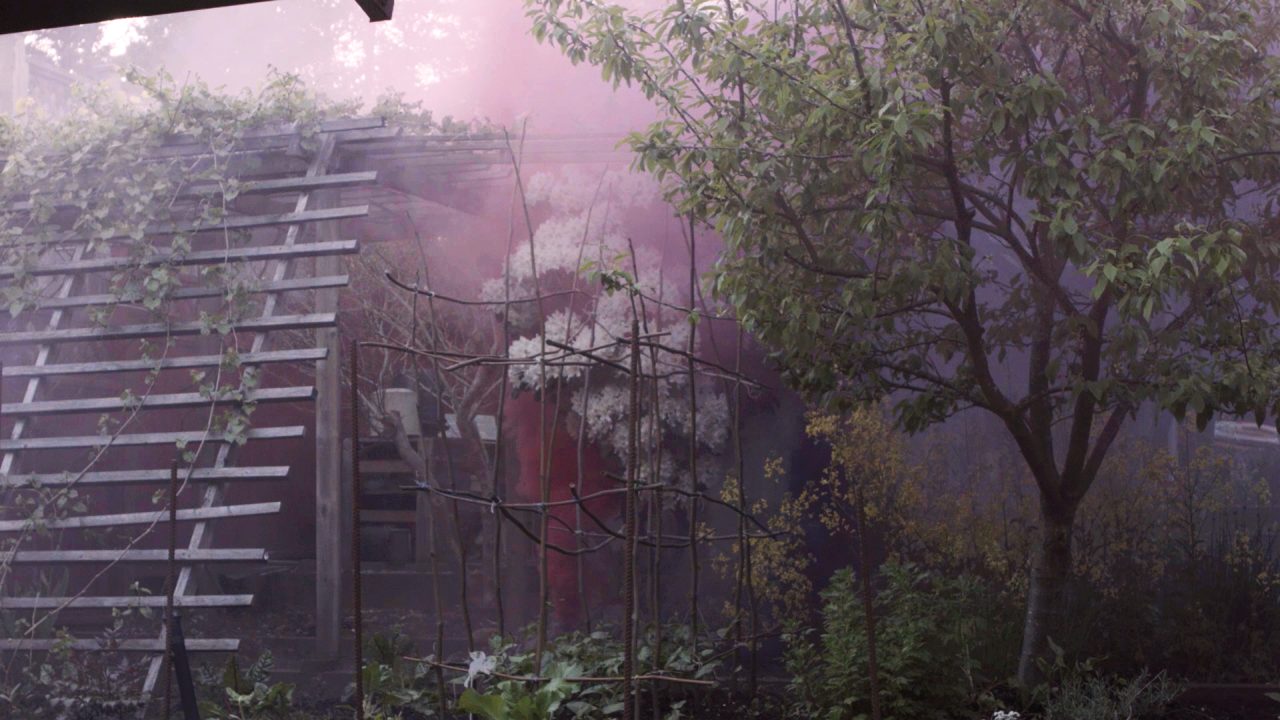
The Willful Plot brings together artists' practices to expand the notion of the garden as a site of tension between wild and cultivated, temporal and perpetual, public and private, sovereign and colonized. Here, the garden is considered by the artists not only as a delineated patch of earth, but as a story and a will to drive that story to complicate the way in which cultures and individuals see themselves in relation to ecology, sociality, belief and possibility. It is an opportunity to look at human relationships with land, flora, fauna and their interrelatedness. In its willfulness, the resistance garden is a counter-site, a heterotopia for alternative cultivation and potential transformation.
[more] -
News
02 Jun 2022
Creating a Bronze Disc Base for Reconciliation Pole
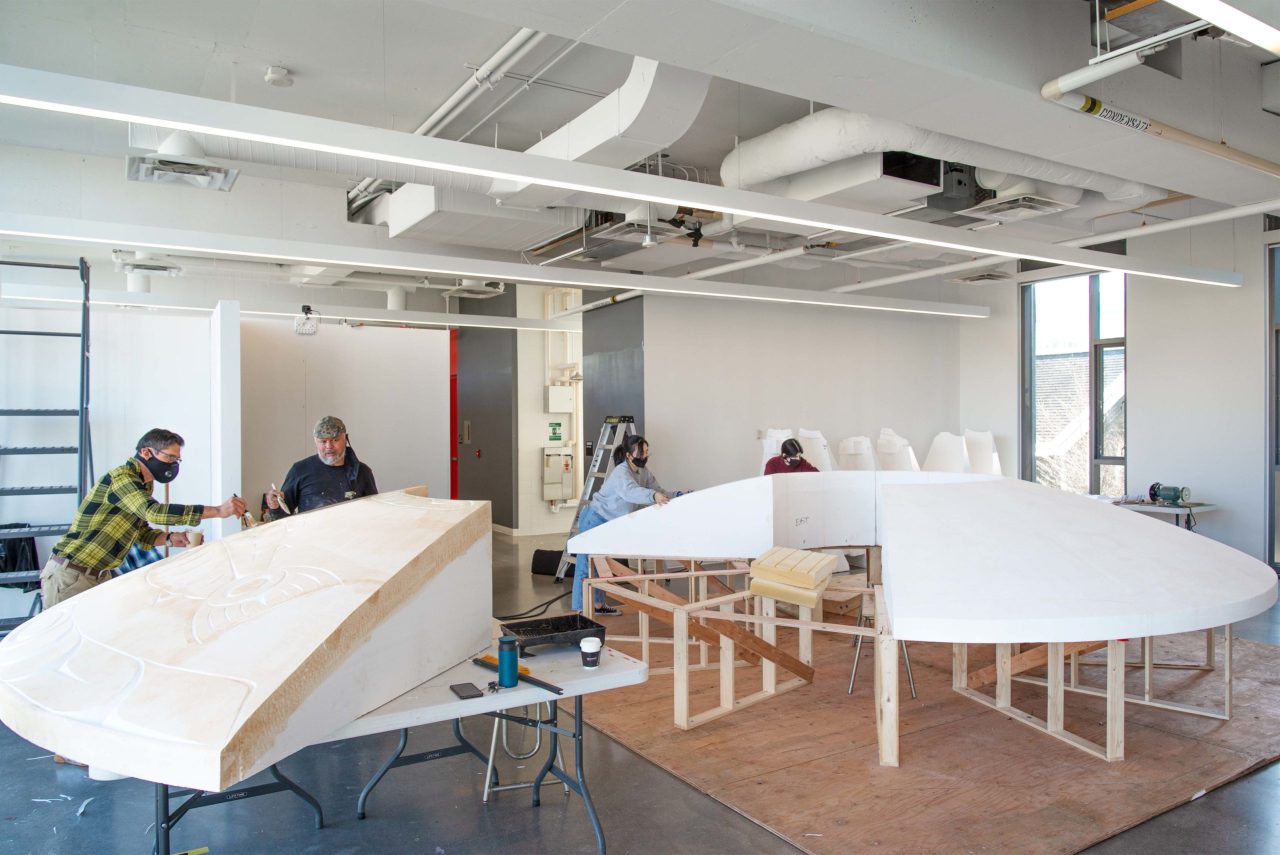
Through a unique collaboration between Musqueam artist Richard Campbell and 7idansuu James Hart (Haida), work is underway on the production of a large-scale cast bronze disc that will be installed at the base of Hart’s Reconciliation Pole (2015-17).
[more] -
News
06 Dec 2021
Outdoor Art: Winter 2021
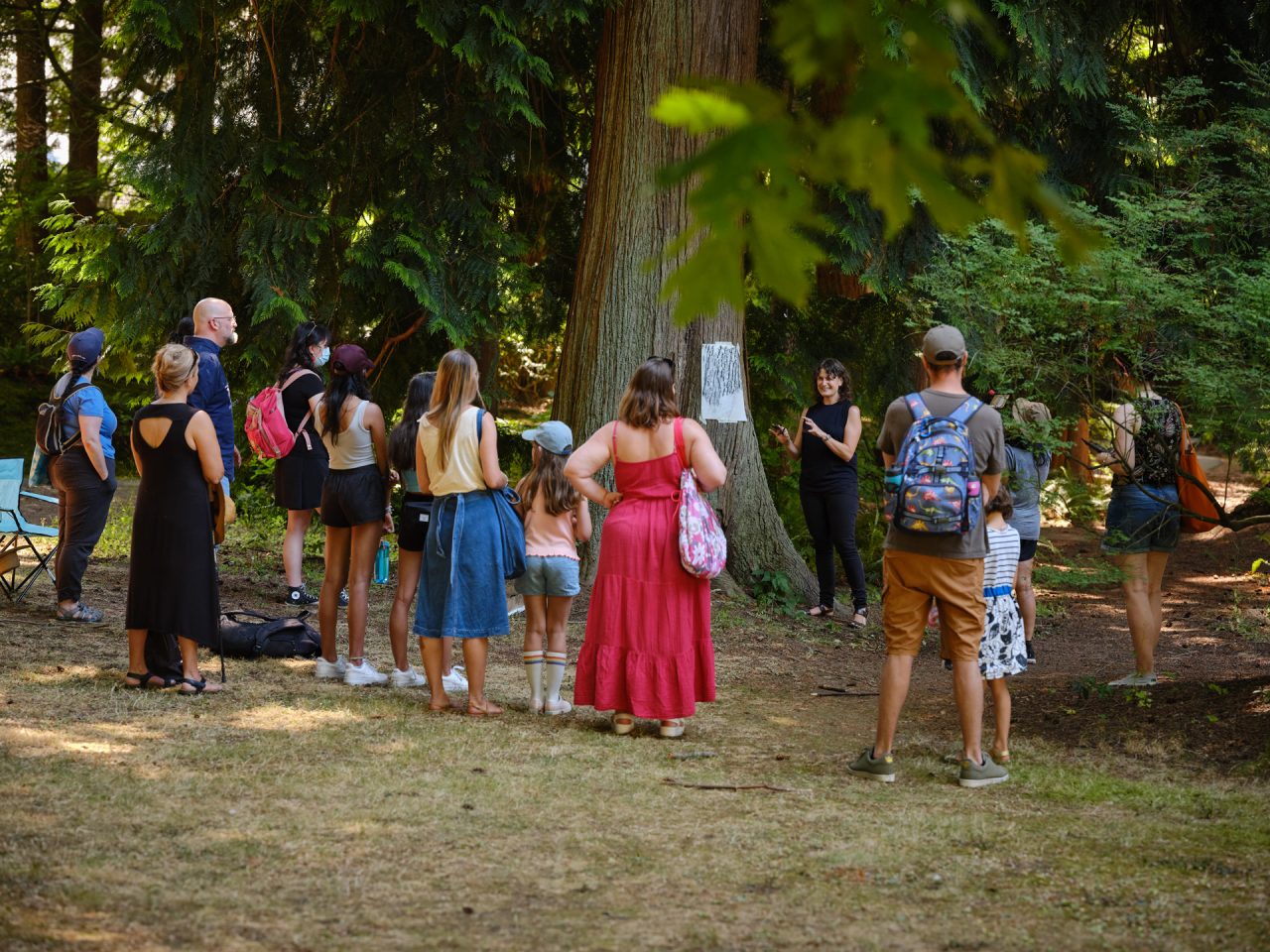
At the Belkin, we often receive questions about the University’s Outdoor Art Collection and what is involved with commissioning, acquiring or accepting donations. Responding to this growing interest, we issue annual outdoor art newsletters to share updates and backstory information about what is involved with curating, stewarding and activating the collection. These newsletters also offer a forum for the Belkin’s curatorial team to share their research and insights about art in public space.
[more] -
Event
2021-24
Holly Schmidt: Fireweed Fields
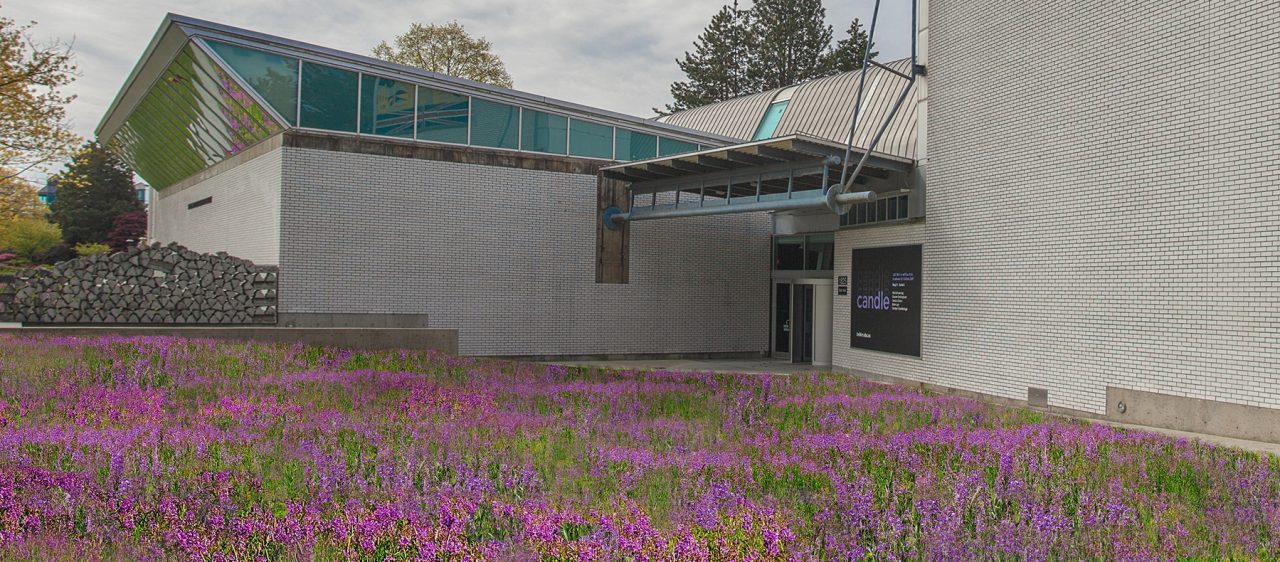
Fireweed Fields transforms a UBC lawn site into a fireweed meadow, encouraging increased biodiversity through gradual succession as a metaphor for the resurgence of life after a crisis. This installation acknowledges the global climate emergency: by tearing through the fabric of maintained lawns and colonial ideals, it plants the initial seeds for change and catalyzes dialogue, creative experimentation, and new biodiversity research and learning opportunities.
[more] -
Exhibition
2019-23
Holly Schmidt: Forecast
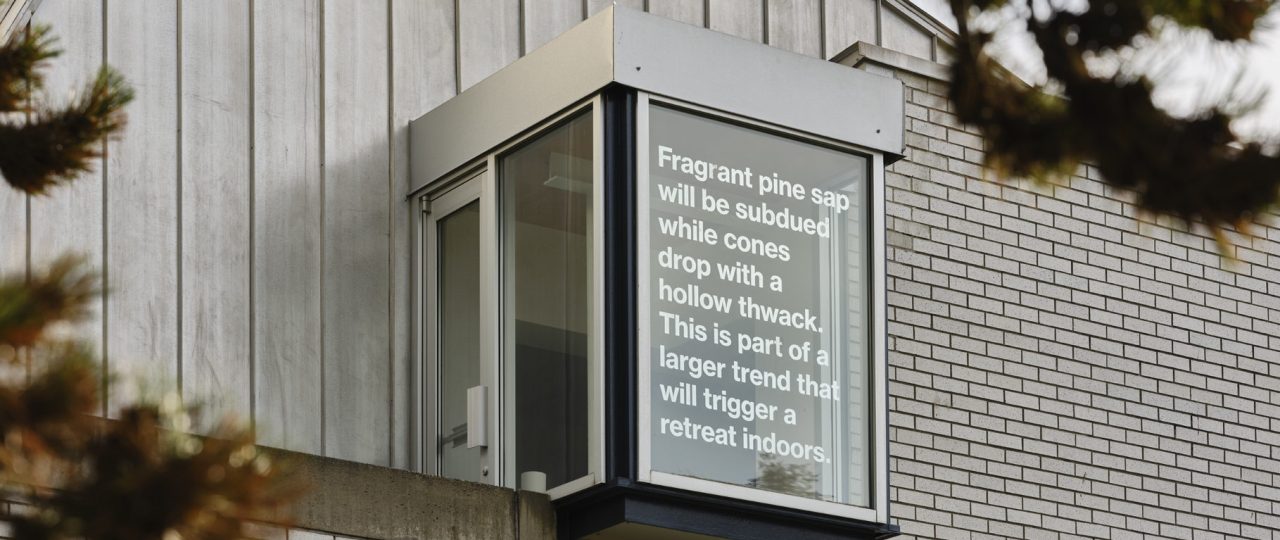
As part of Holly Schmidt’s three-year residency at UBC, the artist presents Forecast (2019-23), the latest in a series of short poetic texts using the language of weather reporting to speculate on collective responses to environmental changes.
[more] -
News
02 Dec 2019
Outdoor Art: Winter 2019
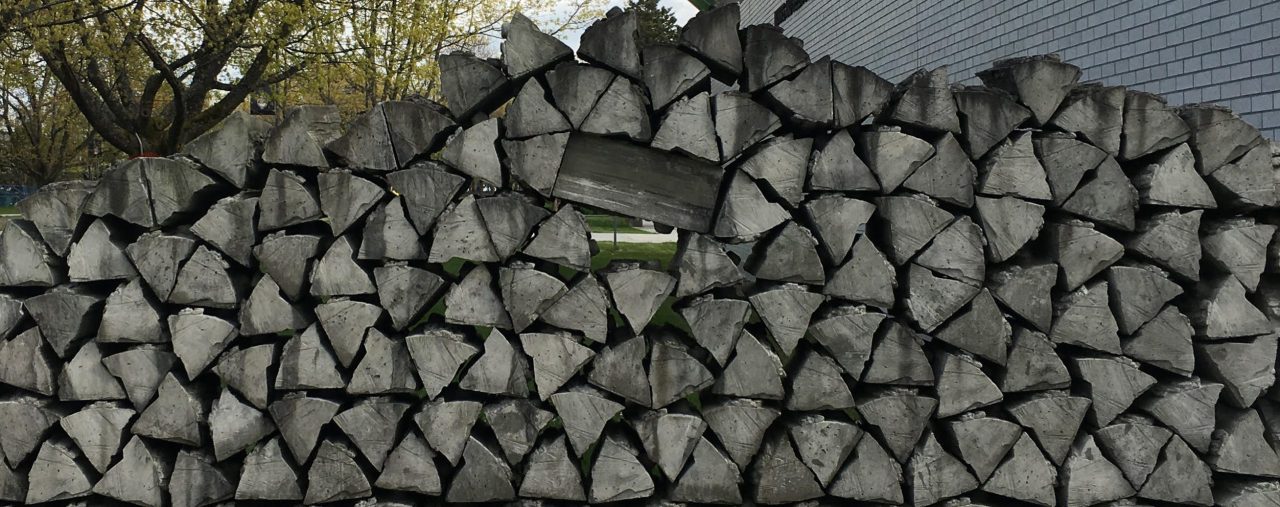 [more]
[more] -
Exhibition
January 2019 – April 2024
Holly Schmidt: Vegetal Encounters Residency
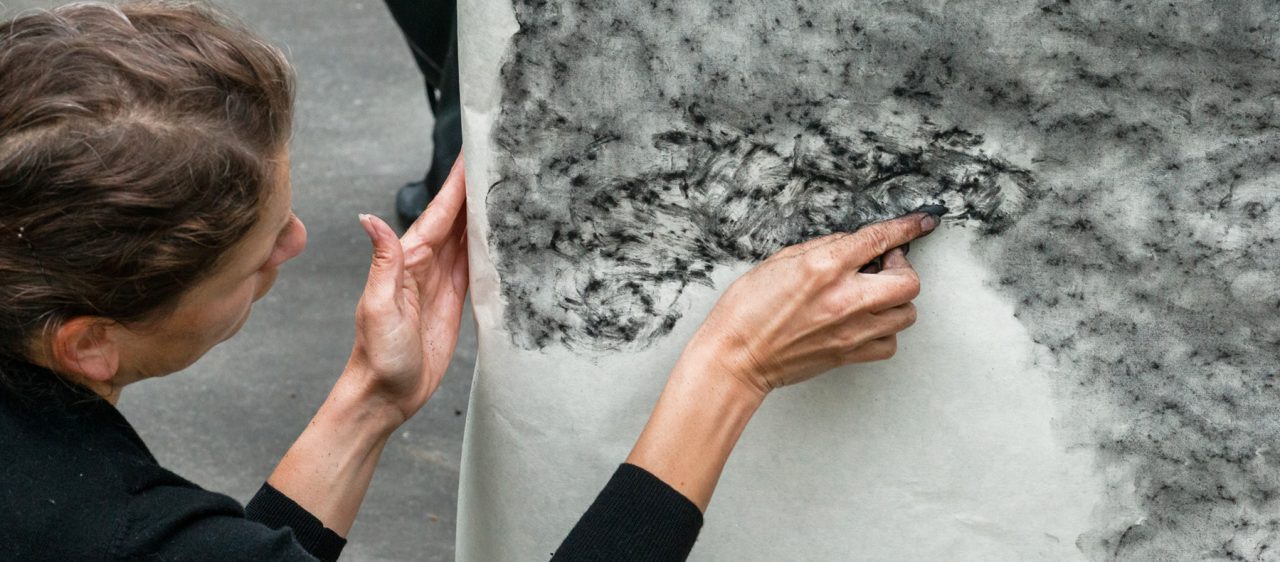
Vegetal Encounters is Holly Schmidt’s three-year residency with the Outdoor Art Program at UBC. Through this residency, Schmidt has been creatively engaging with plant life as a significant source of life, connection and learning.
[more] -
News
14 Nov 2018
Outdoor Art: Fall 2018
 [more]
[more]